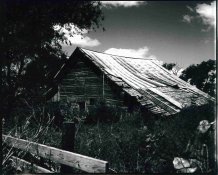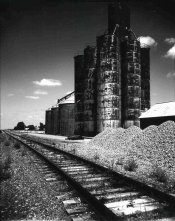I have been working on project creating direct 8x10 prints using Ilford DPP paper. These worked quite well but…
I tested first with 4x5 having used it before and discovered that I had to rate the latest box around ISO 6. I had to convince myself that I had not made some mistake as previous boxes ISO 3 or maybe 4 was order of the day. I also played with using a yellow filter and pre flashing in camera.
I found with the 8x10 I got a different response but quickly, without wasting too many sheets, found that ISO 4 gave pretty consistent results. I used a yellow filter which usually brought in some sky and cloud definition if there was any. Yellow filter says add 1 stop but meter difference through the filter was 1/2 - 2/3 stop. I generally used +1. I also pre-flashed or actually post-flashed by metering through a filter of two sheets of tracing paper and then exposing through the filter at -3 stops from that reading.
For developing I used Ilford PQ 1+9 for 3 mins in a rotary tube hand rolled on a Jobo base. This gave good consistent results with the above parameters.
With the second box I ran off 4 exposures and on all of them I got this mottling effect. I tried with another 2 and got the same. I noticed the batch number was lower sequence than the previous box, contacted B&H and they replaced it. [I’m in US for this but based UK]. I also noticed that dMax was a little weaker so thought that maybe all the issues might be to the PQ developer. With my 4x5 testing I noticed it has to be crystal clear fresh else results suffer, but this was with a 2 week old concentrate half full.
The replacement box arrived and I had decided to try another developer as I though that might be the cause. I only had Dektol and with a little experimentation found that a dilution of 1+3 for 2 mins gave good results. I’m sick of PQ and its short life but Dektol is too expensive in UK so will try Champion Suprol that I have used as a substitute for PQ when reversal developing film.
I also experimented a little with Foma PW developer. With a 4x5 sheet I found I had to use full strength for 5:30 min, which is long but the contrast appeared better controlled to the extent that it appeared a little flat. Trying an 8x10 sheet, after 6:30 min didn't look like it was getting further so I stopped it. The developer become brown, the photo dMax was poor. Looks promising but leaves me to the conclusion that Ilford might use their resources to produce a specific developer for this material as Adox and Foma do for some particular film emulsions they produce.
In conclusion for Harman DPP 8x10, in most situations I got acceptable results I was looking for with these parameters.
Rated at ISO 4 (different to 4x5 )
Use yellow filter +1 stop
Pre (post)-flash in camera through diffusion filter at -3 stops from diffusion meter reading.
Develop in Dektol 1+3 for 2mins tray or rotary. For rotary I found I had to use at least 200ml solutions for good results. Use once. I managed to create a dark space in a walk in cupboard so at night could develop in trays and got similar results.


I tested first with 4x5 having used it before and discovered that I had to rate the latest box around ISO 6. I had to convince myself that I had not made some mistake as previous boxes ISO 3 or maybe 4 was order of the day. I also played with using a yellow filter and pre flashing in camera.
I found with the 8x10 I got a different response but quickly, without wasting too many sheets, found that ISO 4 gave pretty consistent results. I used a yellow filter which usually brought in some sky and cloud definition if there was any. Yellow filter says add 1 stop but meter difference through the filter was 1/2 - 2/3 stop. I generally used +1. I also pre-flashed or actually post-flashed by metering through a filter of two sheets of tracing paper and then exposing through the filter at -3 stops from that reading.
For developing I used Ilford PQ 1+9 for 3 mins in a rotary tube hand rolled on a Jobo base. This gave good consistent results with the above parameters.
With the second box I ran off 4 exposures and on all of them I got this mottling effect. I tried with another 2 and got the same. I noticed the batch number was lower sequence than the previous box, contacted B&H and they replaced it. [I’m in US for this but based UK]. I also noticed that dMax was a little weaker so thought that maybe all the issues might be to the PQ developer. With my 4x5 testing I noticed it has to be crystal clear fresh else results suffer, but this was with a 2 week old concentrate half full.
The replacement box arrived and I had decided to try another developer as I though that might be the cause. I only had Dektol and with a little experimentation found that a dilution of 1+3 for 2 mins gave good results. I’m sick of PQ and its short life but Dektol is too expensive in UK so will try Champion Suprol that I have used as a substitute for PQ when reversal developing film.
I also experimented a little with Foma PW developer. With a 4x5 sheet I found I had to use full strength for 5:30 min, which is long but the contrast appeared better controlled to the extent that it appeared a little flat. Trying an 8x10 sheet, after 6:30 min didn't look like it was getting further so I stopped it. The developer become brown, the photo dMax was poor. Looks promising but leaves me to the conclusion that Ilford might use their resources to produce a specific developer for this material as Adox and Foma do for some particular film emulsions they produce.
In conclusion for Harman DPP 8x10, in most situations I got acceptable results I was looking for with these parameters.
Rated at ISO 4 (different to 4x5 )
Use yellow filter +1 stop
Pre (post)-flash in camera through diffusion filter at -3 stops from diffusion meter reading.
Develop in Dektol 1+3 for 2mins tray or rotary. For rotary I found I had to use at least 200ml solutions for good results. Use once. I managed to create a dark space in a walk in cupboard so at night could develop in trays and got similar results.












